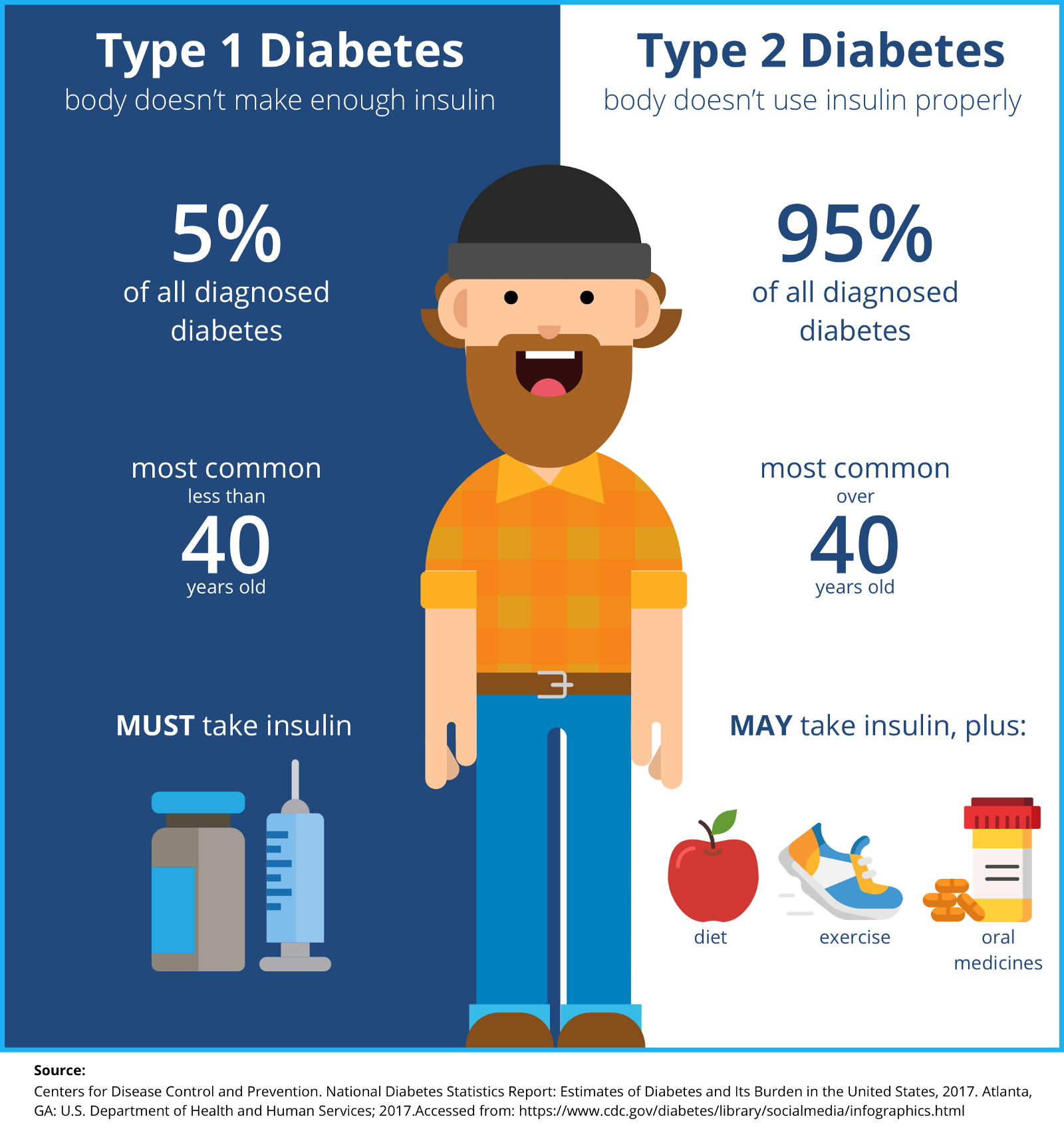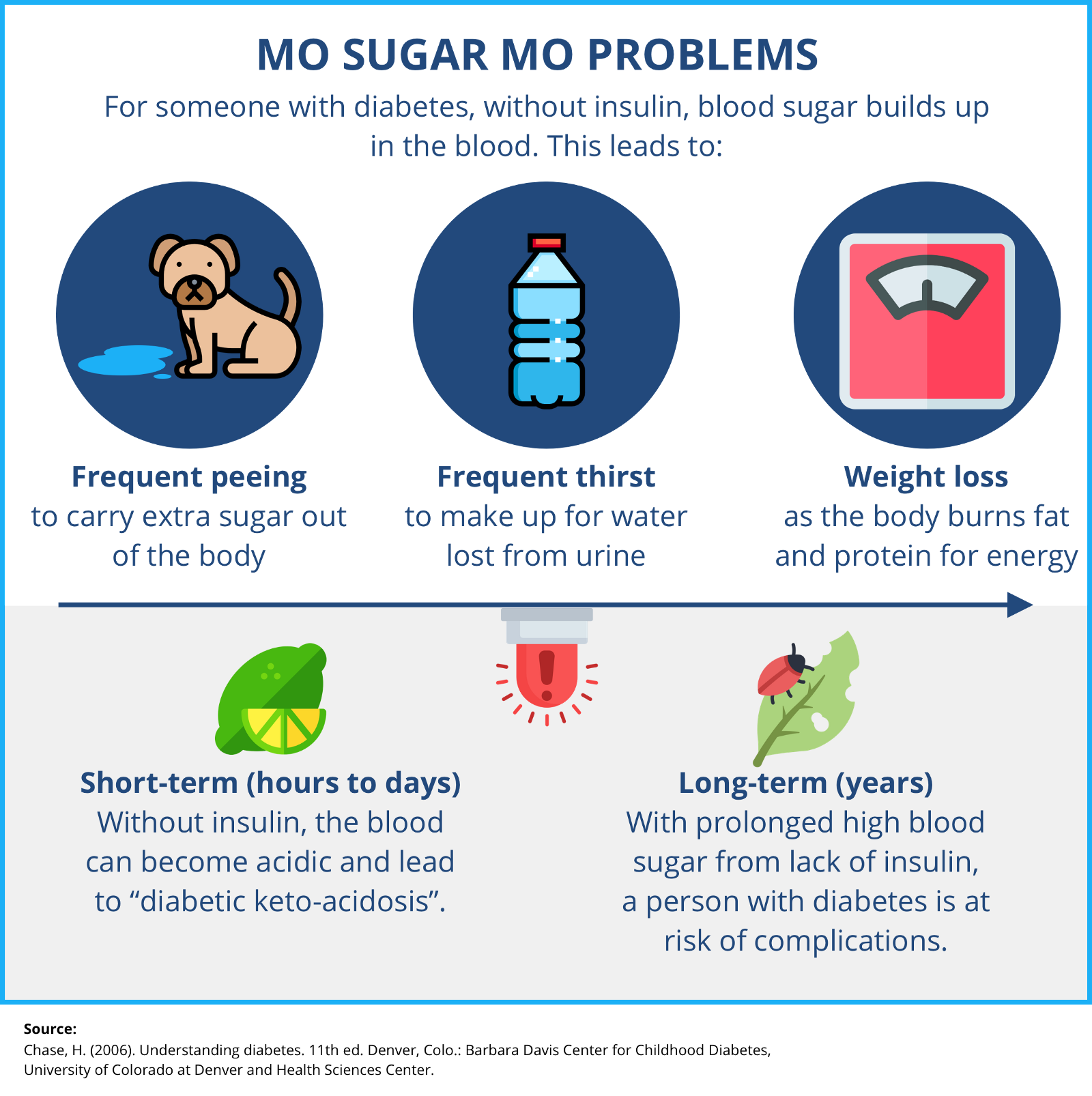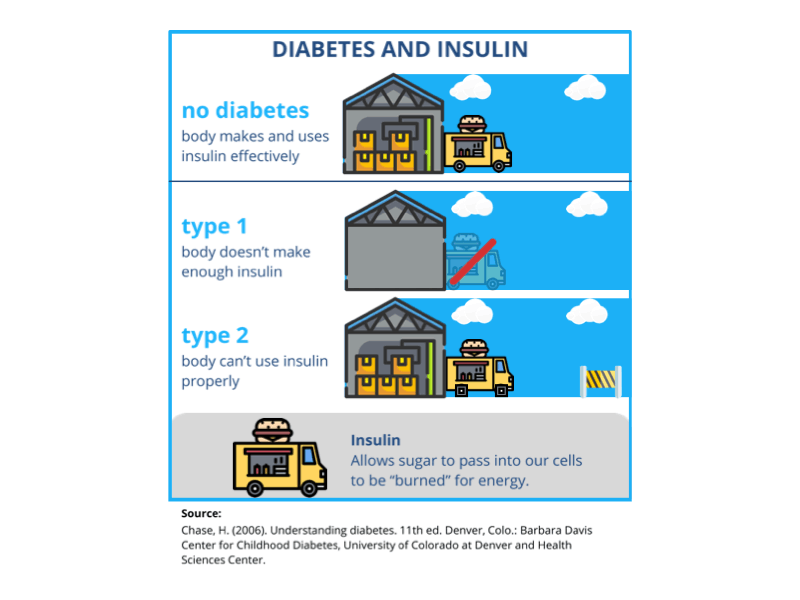Type 1 vs. Type 2 Diabetes

Type 1 vs. Type 2 Diabetes
I love food. I always have. My parents still tell the story of me as a little kid going to dinner at a farm (ok, so I grew up in Indiana…). We were all served fresh steak — and apparently, I wolfed mine down and immediately looked around for more. My mom, not wanting to bring more attention to their food-starved son, proceeded to give me hers. And then…so did my dad…(now that’s true love).
Which is why…when I was first diagnosed with type 1 diabetes, the one thing that scared me more than needles was how it would impact what I could eat (at the time I was a freshman in college whose core diet consisted of dorm food, late-night pizza, and Subway).
So there I was, sitting in a training room at the Hammond Clinic just minutes after being told I had type 1 diabetes. I had been having weird symptoms (like drinking a ton of water, peeing all the time, and losing a bunch of weight) for a couple months and I finally got the answer why.
I was already getting dizzy watching the nurse wave a syringe and plastic orange around when she hit me with the real doozy:
We’re putting you on a 2,000 calorie a day diet plan.

It just didn’t make any sense. I was already 15 pounds underweight as a result of my diagnosis. And after some more research at home, I had type 1 diabetes —an autoimmune condition where my body no longer made enough insulin to regulate the sugar in my body — and I needed to regulate carbs and insulin for the food I ate…not to limit the number of calories I was eating.
Looking back, it’s clear the staff got it wrong. Maybe it was just old-school thinking, but more likely they made the mistake a lot of us do when they hear the word diabetes: they confused type 1 diabetes for type 2 diabetes.
In this article, I’ll share the similarities and differences between type 1 and type 2 diabetes. If you’re reading this, hopefully you come away with a better understanding between the two.
The Problem: Misconceptions
Everyone knows someone with diabetes. It’s a global epidemic, affecting more than 400 million worldwide (and 30+ million in the US alone, representing 10% of the population).
With a diabetes diagnosis comes a ton of preconceptions of what it all means —some true and many others false — not to mention a bunch of questions like:
Is it because you ate too much sugar?
But you look so healthy!
So does this mean you can’t eat candy anymore?
As it turns out, type 1 and type 2 diabetes have some pretty important differences — both with how they affect the body and how they’re managed.
But First: Why It’s Easy to Mix Up Types of Diabetes
People aren’t crazy — there are some really good reasons why they confuse type 1 and type 2 diabetes!
Similarity #1: It’s (literally) in the name
It’s really easy to confuse two things with essentially the same name (because…obviously).
Fun Fact: It began back in 1979, when jettisoning the terms “juvenile onset” and “adult onset” was proposed by an international task force sponsored by the NIH’s National Diabetes Data Group. Between 1979 and 1995, we got the terms insulin-dependent diabetes mellitus type 1 (IDDM) and non-insulin-dependent diabetes mellitus type 2 (NIDDM), which were treatment-based but confusing nonetheless. During the 1990s, another international Expert Committee sponsored by the ADA re-organized the whole scheme and gave us the numerical terms of type 1 and type 2 that we use today. (Source.)
Similarity #2: Prevalence
Another reason is that Type 2 diabetes is just a lot more common than type 1 diabetes. In fact, ~95% of all diabetes cases are type 2 diabetes.
As a result, it just gets more airtime. Just about every one of us has a friend or family member who has type 2 diabetes. So when someone gets diagnosed with type 1, it’s only natural to relate it to what you know.

Similarity #3: They both deal with blood sugar and insulin.
The third reason? Type 1 and type 2 diabetes have a lot in common!
- Both deal with how the body breaks down sugar in the body using insulin.
- Both have similar symptoms for too little sugar or too much sugar.
- Both can be really serious long-term if left untreated.

There are Key Differences Between Type 1 and Type 2 Diabetes
Despite the similarities, there are some really fundamental differences between type 1 and type 2 diabetes.
Difference #1: Causes
In Type 1 Diabetes, the body’s immune system turns against itself, destroying the pancreas cells that produce insulin.
Fun Fact: Normally, the immune system only attacks and destroys invaders like infection. Scientists don’t know exactly why the immune system attacks the pancreas in type 1 diabetes, but it’s believed that it may be triggered by a virus.
Type 2 Diabetes is a progressive condition. Eventually, the pancreas cannot keep up with the demand. Insulin production starts to decline. When there is no longer enough insulin released from the pancreas, the blood glucose level rises too high.
Difference #2: How the Body Handles Insulin
The second key difference is how the body breaks down sugar using insulin.

- For people without diabetes, the body makes insulin to move sugar into cells to be used as energy.
- For people with type 1 diabetes, the body stops producing insulin, so sugar builds up in the blood.
- For people with type 2 diabetes, the body still makes insulin, it just can’t use it properly.
Difference #3: Treatment & Prevention
Type 1 and type 2 diabetes have different treatment approaches as well:
- 100% of people with type 1 diabetes need to take insulin to survive. Their body just doesn’t make it any more, so they rely on injections of insulin to perform the role a pancreas would normally do.
- Many people with type 2 diabetes are able to effectively use diet and exercise to improve how their body uses the insulin it’s making. Still, there are many people with type 2 who do take insulin (~15% — Source).
When it comes to prevention, there’s really not anything you can do to avoid type 1 diabetes (believe me, I wish there were!). For many people with type 2 diabetes, diet and exercise are effective prevention tools to keep your body’s insulin functioning properly.
No matter what the type…always bring a little empathy
Hopefully you learned a little something about type 1 vs. type 2 diabetes! It’s a very common misconception and one that’s easy to get confused.
Regardless of the type, I find it’s best to always bring empathy to the table. People with type 1 and type 2 both have a lot on their plate, so seeking to understand what they go through and finding ways to help always go a long way.
We’re all in this together.
